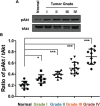Association of HOTAIR expression with PI3K/Akt pathway activation in adenocarcinoma of esophagogastric junction
- PMID: 28352764
- PMCID: PMC5329795
- DOI: 10.1515/med-2016-0008
Association of HOTAIR expression with PI3K/Akt pathway activation in adenocarcinoma of esophagogastric junction
Abstract
Objectives: Although the Hox transcript antisense intergenic RNA (HOTAIR), a vital long non-coding RNA, is known to participate in the development and progression of a wide range of carcinomas, there are still no published reports regarding its expression in adenocarcinoma of esophagogastric junction (AEJ). The aims of this study were to investigate the expression of HOTAIR, and to analyze the association of its expression with PI3K/Akt pathway activation in clinical AEJ patients.
Methods: Nine normal epithelial tissues and 41 samples of AEJ were studied comparably. The expression of HOTAIR was detected by real-time PCR according to the different tumor grades in these AEJ tissues. Western blot was performed to reveal the Ser473-phosphorylated Akt and total Akt levels. Results: HOTAIR was found to be up-regulated in higher grades of AEJ tissues compared to low grades and/or noncancerous tissues. pAkt expression was also found to be up-regulated in tissues of higher tumor stages. We found that the overexpression of HOTAIR finely correlated with elevated Ser473-phosphorylated Akt levels. Conclusion: Upregulated HOTAIR was associated with abnormal activated PI3K/Akt pathway, which might serve as a promising therapeutic strategy for AEJ treatment.
Keywords: AEJ; HOTAIR; PI3K/Akt pathway.
Figures



Similar articles
-
LncRNA HOTAIR improves diabetic cardiomyopathy by increasing viability of cardiomyocytes through activation of the PI3K/Akt pathway.Exp Ther Med. 2018 Dec;16(6):4817-4823. doi: 10.3892/etm.2018.6755. Epub 2018 Sep 18. Exp Ther Med. 2018. PMID: 30542437 Free PMC article.
-
Knockdown of lncRNA-HOTAIR downregulates the drug-resistance of breast cancer cells to doxorubicin via the PI3K/AKT/mTOR signaling pathway.Exp Ther Med. 2019 Jul;18(1):435-442. doi: 10.3892/etm.2019.7629. Epub 2019 May 29. Exp Ther Med. 2019. PMID: 31281438 Free PMC article.
-
Long Noncoding RNA HOTAIR Promotes Endometrial Carcinoma Cell Proliferation by Binding to PTEN via the Activating Phosphatidylinositol 3-Kinase/Akt Signaling Pathway.Mol Cell Biol. 2019 Nov 12;39(23):e00251-19. doi: 10.1128/MCB.00251-19. Print 2019 Dec 1. Mol Cell Biol. 2019. PMID: 31527078 Free PMC article.
-
LncRNA HOTAIR promotes cisplatin resistance in gastric cancer by targeting miR-126 to activate the PI3K/AKT/MRP1 genes.Tumour Biol. 2016 Dec;37:16345–16355. doi: 10.1007/s13277-016-5448-5. Epub 2016 Nov 30. Tumour Biol. 2016. PMID: 27900563
-
The HOTAIR lncRNA: A remarkable oncogenic promoter in human cancer metastasis.Oncol Lett. 2021 Apr;21(4):302. doi: 10.3892/ol.2021.12563. Epub 2021 Feb 17. Oncol Lett. 2021. PMID: 33732378 Free PMC article. Review.
Cited by
-
Targeting PI3K in cancer: mechanisms and advances in clinical trials.Mol Cancer. 2019 Feb 19;18(1):26. doi: 10.1186/s12943-019-0954-x. Mol Cancer. 2019. PMID: 30782187 Free PMC article. Review.
-
Characteristics of auto-quantified tumor-infiltrating lymphocytes and the prognostic value in adenocarcinoma of the esophagogastric junction, gastric adenocarcinoma, and esophageal squamous cell carcinoma.Aging (Albany NY). 2024 Jul 5;16(13):11027-11061. doi: 10.18632/aging.205999. Epub 2024 Jul 5. Aging (Albany NY). 2024. PMID: 38975889 Free PMC article.
-
Portraying breast cancers with long noncoding RNAs.Sci Adv. 2016 Sep 2;2(9):e1600220. doi: 10.1126/sciadv.1600220. eCollection 2016 Sep. Sci Adv. 2016. PMID: 27617288 Free PMC article.
-
Association of metabolism-related genes polymorphisms with adenocarcinoma of the oesophagogastric junction: Evidence from 2261 subjects.J Cell Biochem. 2019 Nov;120(11):18689-18701. doi: 10.1002/jcb.29167. Epub 2019 Jun 18. J Cell Biochem. 2019. PMID: 31211453 Free PMC article.
-
HOTAIR: a potential metastatic, drug-resistant and prognostic regulator of breast cancer.Mol Cancer. 2023 Mar 30;22(1):65. doi: 10.1186/s12943-023-01765-3. Mol Cancer. 2023. PMID: 36997931 Free PMC article. Review.
References
-
- Monig SP, Schroder W, Beckurts KT, Holscher AH.. Classification, diagnosis and surgical treatment of carcinomas of the gastroesophageal junction. Hepatogastroenterology. 2001 Sep-Oct;48(41):1231–1237. - PubMed
-
- Pohl H, Welch HG.. The role of overdiagnosis and reclassification in the marked increase of esophageal adenocarcinoma incidence. J Natl Cancer Inst. 2005 Jan 19;97(2):142–146. - PubMed
-
- Hu W, Liang Y, Zhang S, Hu Y, Liu J.. The significance of subcarinal dissection in esophageal cancer surgery. Asia Pac J Clin Oncol. 2014;10(2):183–189. - PubMed
LinkOut - more resources
Full Text Sources
Other Literature Sources
Molecular Biology Databases
